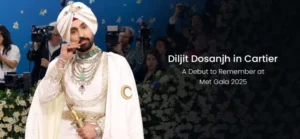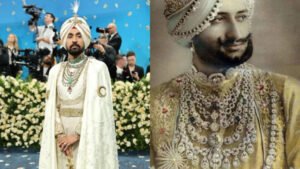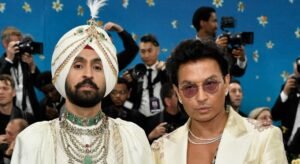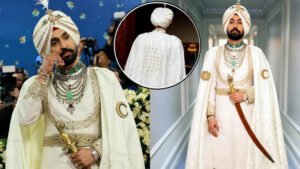Diljit Dosanjh Makes History at the 2025 Met Gala with a Regal Ode to Punjabi Heritage

In the heart of Manhattan, where fashion’s most coveted red carpet unfurls each year at the Met Gala, Punjabi singer-actor Diljit Dosanjh delivered a breathtaking moment that will be remembered as a landmark in cultural representation. Making his debut at the 2025 Met Gala, Dosanjh arrived in a resplendent custom ensemble by acclaimed designer Prabal Gurung—an ivory sherwani paired with a gold-embroidered cloak and a regal turban adorned with a jeweled sarpech (turban ornament). His look was more than just a fashion statement—it was a proud and poignant celebration of identity, heritage, and the power of storytelling through style.
A Tailored Tribute to Roots

The 2025 Met Gala theme, “Superfine: Tailoring Black Style,” focused on the elegance, artistry, and cultural significance of Black dandyism and bespoke tailoring. While the central narrative spotlighted Black fashion history, it also invited a global conversation on how marginalized communities have historically embraced tailoring as a form of self-expression, resistance, and pride. Diljit Dosanjh seized the moment to reflect a parallel narrative from his own culture—Punjabi Sikh heritage—with a look that commanded attention and respect.
His ivory sherwani was a masterpiece of subtle elegance. Crafted with meticulous attention to detail, it featured traditional threadwork that paid homage to the intricate embroidery techniques native to North India. The sherwani was paired with a flowing cloak in ivory and gold, lined with ornate motifs that echoed Mughal-inspired artistry. The ensemble exuded regality without being ostentatious—perfectly aligned with the restrained opulence that Punjabi formal wear often embodies.
But what truly elevated the look was the turban. In Sikh culture, the turban is more than a piece of cloth—it is a symbol of dignity, identity, and spiritual commitment. Diljit’s choice to wear a turban on the world’s most-watched fashion carpet was a powerful act of representation. The turban was elegantly tied and featured a shimmering sarpech—reminiscent of the kind worn by Punjabi royalty during the pre-colonial and colonial eras. Adorned with stones and pearls, it transformed his appearance into something almost cinematic—a living portrait of cultural pride.
Prabal Gurung: A Designer with Shared Roots

Behind the majestic outfit was none other than Prabal Gurung, the Nepalese-American designer known for combining global aesthetics with local traditions. Gurung has consistently used his platform to spotlight Asian voices and challenge Western fashion norms. For the Met Gala, he and Diljit collaborated not just as artist and muse, but as two South Asians committed to broadening fashion’s narrative to include their culture, stories, and traditions.
In interviews leading up to the event, Gurung revealed that their joint inspiration came from historical Sikh rulers and modern South Asian tailoring. “We wanted to create something that would speak to the legacy of Punjabi valor and grace,” he said. “Diljit brought that legacy to life with authenticity, charisma, and grace.”
The ensemble also carried subtle, layered meanings. The gold embroidery symbolized prosperity and divine light—a nod to the Sikh concept of Chardi Kala, or perpetual optimism. The flow of the cloak symbolized spiritual freedom, and the minimalistic palette hinted at the harmony between luxury and humility.
A Moment of Cultural Significance

For many viewers—especially South Asians worldwide—seeing Diljit walk the Met Gala carpet in full cultural attire was more than just a celebrity fashion moment; it was a deep affirmation of identity. It broke away from the long-standing trend where Indian or South Asian celebrities often wear Western haute couture, opting to blend in with global norms. Diljit, on the other hand, stood out because he leaned into his cultural roots.
Social media platforms erupted with praise. Hashtags like #DiljitAtMetGala, #SherwaniSupremacy, and #SikhStyle began trending in India, Canada, the UK, and the U.S. Fans commended not only his appearance but also what it symbolized: confidence in one’s heritage, elegance in cultural attire, and the unfiltered power of authenticity.
Fashion critics echoed this sentiment. Vogue India called him “the most regal man on the carpet,” while The New York Times noted how Dosanjh’s look “challenged and expanded the fashion vocabulary of the Met Gala.”
The Man Behind the Turban

Diljit Dosanjh has long been a cultural juggernaut. Born in Dosanjh Kalan, a small village in Punjab, he rose to fame with his distinct blend of traditional Punjabi music and modern pop stylings. Over the years, he’s successfully crossed over into Bollywood and even performed in major arenas across North America, including Coachella in 2023. His music has consistently championed Punjabi language, culture, and issues, making him a role model for the South Asian diaspora.
However, this moment at the Met was perhaps his most globally visible assertion of identity. In many ways, it brought his career full circle—from a young man singing Punjabi folk songs to a cultural ambassador representing the richness of his roots on the world’s biggest fashion stage.
In a brief statement to the press, Diljit said:
“Tonight isn’t just about fashion. It’s about who we are. I’m here to show that our traditions, our clothes, and our history have a place at the highest table.”
Legacy in the Making

By the end of the night, Diljit Dosanjh’s appearance had already entered the annals of Met Gala history. His regal sherwani look was included in nearly every “Best Dressed” list. But more importantly, he inspired a generation to see their traditions as fashionable, their identity as valid, and their stories as worth telling.
Fashion has often been criticized for cultural appropriation. What Diljit presented was the antithesis of that: cultural celebration, done with integrity, elegance, and profound respect.
In a world where cultural homogenization often dominates celebrity aesthetics, Diljit Dosanjh showed the power of standing tall—turban and all.

